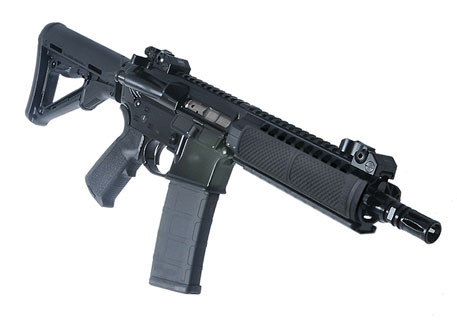Firearms in America
I do my best to provide unbiased information pertaining to different types of firearms, manufacturers, and laws. Certain sections of this site focus on specific areas and topics related to firearms. I only post information on topics and items that I can speak intelligently about. If I am not educated on a specific topic or item then you will not find it here.
Now for the disclaimers; I am not a gunsmith, lawyer, law enforcement officer, or gun control lobbyist. Nor do I play one on television. Any information contained on this site contains no warranty or guarantee of any kind. This site exists for the sole purpose of being useful to those who are less educated about firearms.
AR-15: negatives to a short barrel?
The standard configuration for an AR-15 uses a 16" barrel. This is often referred to as carbine length. However, there are some cases where it is advantageous to have a shorter barrel length. The main reasons being to save weight and space when using indoors.
Once you go below 16" it must be registered on a form 1 with the ATF as a short barrel rifle. You may choose any length but the most popular choices are 12.5", 10.5", and even 7.5" in some cases. It is important to know the shorter you go in barrel length, the less velocity you will generate. In addition, you may need to use heavier bullets as they tend to remain stable with less velocity. I'm not saying you can't shoot a 10.5" barrel out to 300 yards because you can. It just won't be as consistent as a 14 or 16 inch barrel.
 One of the biggest downsides to having a short barrel is the amount of muzzle flash/report. A 7.5" barrel is brutal to fire indoors, and generates a report similar to a flash bang. In addition, the amount of concussion associated with these barrels is also significant. I remember standing a few feet behind a friend of mine who was shooting a 10.5" AR-15 and I could feel the concussion of each shot against my chest. Even with a decent flash hider, the amount of muzzle flash would definitely blind the shooter in the dark.
One of the biggest downsides to having a short barrel is the amount of muzzle flash/report. A 7.5" barrel is brutal to fire indoors, and generates a report similar to a flash bang. In addition, the amount of concussion associated with these barrels is also significant. I remember standing a few feet behind a friend of mine who was shooting a 10.5" AR-15 and I could feel the concussion of each shot against my chest. Even with a decent flash hider, the amount of muzzle flash would definitely blind the shooter in the dark.
When shooting a short barreled full-auto it's very difficult to deal with the increased recoil. Shots are often kept to short 2 or 3 round bursts otherwise the weapon tends to climb for the sky. One way of dealing with the concussion problem on a short barrel is to add a suppressor. Although, some manufacturers will not warranty their products on barrels shorter than "X" inches. Also, a short barrel means less volume for expanding gasses to bleed off. The extra back pressure from a suppressor will force a significant amount of gas out the breech making it very unpleasant for the shooter. One good way to combat this is to use a piston-driven system or adjustable system like the Noveske switchblock.
AR-15: choosing optics
One questions I get often is, "Which type of optic is best for my AR-15?" There isn't a blanket answer to the question. There are several factors to consider when buying an optic for your AR-15.
First, where are you shooting? Are you limited to a 25 or 50 yard indoor range? Most people make the mistake of buying a traditional hunting style scope when they buy their first AR-15. It looks cool and the gun is meant to shoot long range right? Considering the additional weight and costs associated with a high quality magnified scope it's not always the best option.
Second, how is your vision? Older shooters will probably benefit from the use of a magnified scope. Even if you are shooting at relatively short distances like 25 or 50 yards. I have 20/20 vision and I'll admit that it's tough for me to shoot bowling pins at 100 yards with an unmagnified EOTech.
Here are three lists of optics I would suggest for first time AR-15 owners. I have separated them into lists by price and I have personally used all of these optics they work great depending on your situation.
Entry level optics - on the cheap side, but still decent quality
Pro level optics - mid to high priced, great build quality/performance
- EOTech XPS 2
- Aimpoint CompM4
- Burris AR Tact Prism Sight
- Leupold VX-R
- Trijicon ACOG
- Zeiss Conquest HD5
Elite level optics - high to ridiculous priced, outstanding build quality/performance
Some of the optics listed above are non-magnified and some are variable power. Again, this will depend on where you are shooting, but most of the optics have different models/options to better suit your needs. None of the optics listed above are junk. If you are looking for something in the elite level, then you probably already know about these optics.
Keep in mind, even if you have very deep pockets, an elite optic is not going to make you an expert marksman. Like everything else, you will need experience behind the trigger and a very good understanding of ballistics to fully appreciate and reap the benefits of those optics.
If you want to know more about what makes the elite level optics so expensive see my article on high priced optics.
 12/01/11 11:19:00 am,
12/01/11 11:19:00 am, 